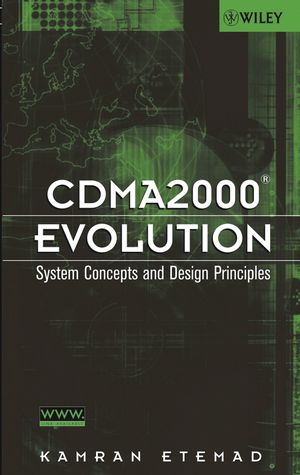CDMA2000 Evolution: System Concepts and Design PrinciplesISBN: 978-0-471-46125-8
Hardcover
384 pages
September 2004
 This is a Print-on-Demand title. It will be printed specifically to fill your order. Please allow an additional 10-15 days delivery time. The book is not returnable.
|
||||||
Acknowledgments.
Acronyms.
Chapter 1. Introduction to CDMA2000 Standards Evolution.
1.1 Introduction.
1.2 3GPP2 and CDMA2000 Standardization.
1.3 cdmaONE Evolution to cdma2000.
1.4 References.
Chapter 2. CDMA Concepts.
2.1 Introduction.
2.2 Spread Spectrum Concept.
2.3 Spreading Codes.
2.3.1 Walsh Codes.
2.3.2 PN Codes.
2.4 Multi-path Diversity and Rake Receiver.
2.5 Universal Frequency Reuse.
2.6 Soft Hand Off.
2.7 Power Control and Soft Capacity.
2.8 References.
Chapter 3. Overview of IS95A.
3.1 Introduction.
3.2 Radio and Physical Channelization.
3.3 Reverse Link Physical Channels.
3.3.1 Access Channel.
3.3.2 Reverse Traffic Channels.
3.3.3 Reverse Link Physical Layer Processing.
3.4 Forward Link Channels.
3.4.1 Pilot Channel and PN Offsets.
3.4.2 Synch Channel.
3.4.3 Paging Channel.
3.4.4 Forward Traffic Channel.
3.4.5 Forward Physical Channel Processing.
3.5 Random Access Channel Operation.
3.6 Power Control Schemes in IS95A.
3.6.1 Access Power Control.
3.6.2 Open Loop Power Control on the Traffic Channel.
3.6.3 Closed Loop Power Control on Reverse Traffic Channel.
3.6.4 Forward Link Power Control.
3.7 Traffic Channel Hand Off in IS95A.
3.7.1 Soft Hand Off Scenarios.
3.7.2 Soft Hand-off Process and Parameters.
3.8 References.
Chapter 4. New Concepts and Technologies in cdma2000.
4.1 Introduction.
4.2 Link Adaptation.
4.2.1 Adaptive Modulation and Coding.
4.2.2 Variable Channelization Spreading.
4.2.3 Physical Layer Hybrid ARQ and Incremental Redundancy.
4.3 Multiuser Diversity.
4.4 Beam-forming.
4.5 Turbo Codes.
4.6 Transmit Diversity.
4.7 Network Controlled Selectable Mode Vocoder (SMV).
4.8 References.
Chapter 5. CDMA2000 Protocol Layers and ChannElization.
5.1 Introduction.
5.2 Physical Layer.
5.3 Link Layer (Layer 2).
5.3.1 MAC Sublayer.
5.3.2 LAC Sublayer.
5.4 Layer 3 Signaling.
5.5 CDMA2000 Physical Channelization.
5.5.1 Reverse Link Physical Channels.
5.5.2 Forward Link Physical Channels.
5.6 References.
Chapter 6. CDMA2000 Physical Layer Features.
6.1 Introduction.
6.2 Spectrum Support and Radio Configurations.
6.3 Radio Configurations and Traffic Channel Data Rates.
6.4 Data Rates on Reverse Common Physical Channels.
6.5 Data Rates on Forward Common Physical Channels.
6.6 Reverse and Forward Link Channel Coding.
6.7 Reverse Link Spreading and Modulation.
6.7.1 Reverse Link Orthogonal Channelization Spreading.
6.7.2 Reverse Link Quadrature Spreading and Modulation.
6.8 Spreading and Modulation in the Forward Link.
6.8.1 Forward Link Orthogonal Channelization Spreading.
6.8.2 Forward Link Quadrature Spreading and Modulation.
6.9 References.
Chapter 7. IS2000 Call Processing.
7.1 Introduction.
7.2 Mobile Station Initialization State.
7.3 Mobile Stations Idle State.
7.3.1 Monitoring the Forward Common and Broadcast Channels.
7.3.2 Monitoring Broadcast Messages on F-PCH.
7.3.3 Monitoring Broadcast Messages on F-BCCH and F-CCH.
7.3.4 Monitoring Quick Paging Channel.
7.3.5 Response to Overhead Information.
7.3.6 Idle Handoff.
7.4 System Access State.
7.4.1 Enhanced Random and Reservation Access Procedures.
7.4.2 Access State Handoffs.
7.4.3 Registration.
7.5 References.
Chapter 8. Traffic Channel Operation.
8.1 Introduction.
8.2 Traffic Channel Service Configuration and Negotiation.
8.3 Voice and Data Transmission on Traffic Channels.
8.3.1 Forward SCH Assignment.
8.3.2 Reverse SCH Assignment.
8.3.3 Admission Control and Traffic Channel Allocation.
8.4 Traffic Channel Hand Off.
8.4.1 Traffic Channel Soft Hand Off.
8.4.2 Dynamic Thresholds for Soft Handoff.
8.4.3 Soft Hand off for Supplemental Channels.
8.4.4 CDMA-to-CDMA Hard Handoff.
8.5 Traffic Channel Power Control.
8.5.1 Forward Traffic Channel Power Control.
8.5.2 Reverse Traffic Channel Power Control.
8.6 Reference.
Chapter 9. CDMA2000 Network Architecture.
9.1 Introduction.
9.2 Legacy cdmaONE Networks.
9.3 New Network Elements in CDMA2000.
9.4 New Network Element Interfaces in CDMA2000.
9.5 Mobility Management for Packet Data Service.
9.5.1 Inter-PCF and Intra PDSN Handoff.
9.5.2 Inter PDSN Handoff.
9.5.3 Inter-PDSN Fast Hand off.
9.6 3GPP2 CDMA2000 Network Model.
9.7 3GPP2 All IP Network Model.
9.8 End-to-End QoS Network Model.
9.9 Positioning System in cdma2000.
9.10 References.
Chapter 10. 1xEV-DO (HRPD) Air Interface.
10.1 Introduction.
10.2 Air Interface Protocol Layers.
10.3 Physical and Logical Channelization.
10.3.1 Forward Link Channels.
10.3.2 Reverse Link Channels.
10.4 Forward Physical Channel Structure.
10.4.1 Forward Traffic Channel Structure.
10.4.2 Forward MAC Channel Structure.
10.4.3 Quadrature Spreading and Modulation.
10.5 Reverse Physical Channel Structure.
10.5.1 Reverse Traffic Channel Structure.
10.5.2 Reverse Access Channel Structure.
10.5.3 Quadrature Spreading and Modulation.
10.6 Forward Link Data Transmission.
10.6.1 Forward Rate Selection.
10.6.2 Forward Link Packet Scheduling.
10.6.3 Hybrid ARQ and Multi-slot Data Transmission on the Forward Link.
10.7 Data Transmission on the Reverse Link.
10.7.1 Data Rate Selection for Reverse Data Channel.
10.7.2 Power Control on the Reverse Traffic Channel.
10.7.3 Cell/Sector Reselection.
10.8 Enhancement in HRPD/IS856 Release A.
10.8.1 Reverse Link Enhancements.
10.8.2 Forward Link Enhancements.
10.8.3 Improved Handoff and Faster Paging.
10.9 HRPD Network Architecture.
10.10 HRPD-IS2000 Hybrid Networks.
10.11 References.
Chapter 11. CDMA2000 Release D (1xEV-DV).
11.1 Introduction.
11.2 1X-EV DV Protocol Layers.
11.3 New Physical Channels in 1xEV-DV (Rel. C and D).
11.4 Channel Configuration Capabilities for Release D.
11.5 Forward Packet Data Channel Operation.
11.5.1 F-PDCCH Processing.
11.5.2 Hybrid ARQ on F-PDCH.
11.6 Channel Quality Measurement and Cell Switch.
11.7 Reverse Packet Data Channel Operation.
11.8 Physical Layer Structure for the New Channels.
11.8.1 Forward Packet Data Control Channel Structure.
11.8.2 Forward Packet Data Channel Structure.
11.8.3 Reverse Packet Data and Control Channels.
11.9 Other Enhancements in 1xEV-DV.
11.9.1 Broadcast/Multicast Service (BCMCS).
11.9.2 Fast Call Setup.
11.9.3 Other Signaling Enhancements.
11.10 References.
Chapter 12. Radio Performance and Network Planning.
12.1 Introduction.
12.2 cdma2000 Coverage and Link Budget Analysis.
12.2.1 IS2000 Reverse Link Budget Analysis.
12.2.2 IS2000 Forward Link Budget Analysis.
12.3 cdma2000 Voice and Data Capacity Performance.
12.4 1xEV-DO Coverage and Capacity Performance.
12.5 Radio Network Dimensioning and Planning Issues.
12.5.1 Greenfield Deployment.
12.5.2 Migration or Expansion of an Existing Network.
12.6 References.
Chapter 13. Overview of Other IMT2000 Standards.
13.1 Introduction.
13.2 IMT2000-Direct Spread, UMTS-FDD (WCDMA).
13.3 High Speed Downlink Packet Access (HSDPA).
13.4 IMT2000-TDD (TD-CDMA).
13.5 UMTS Network Architecture.
13.6 References.
Index.



